Amherst’s Neighboring Towns: Leverett
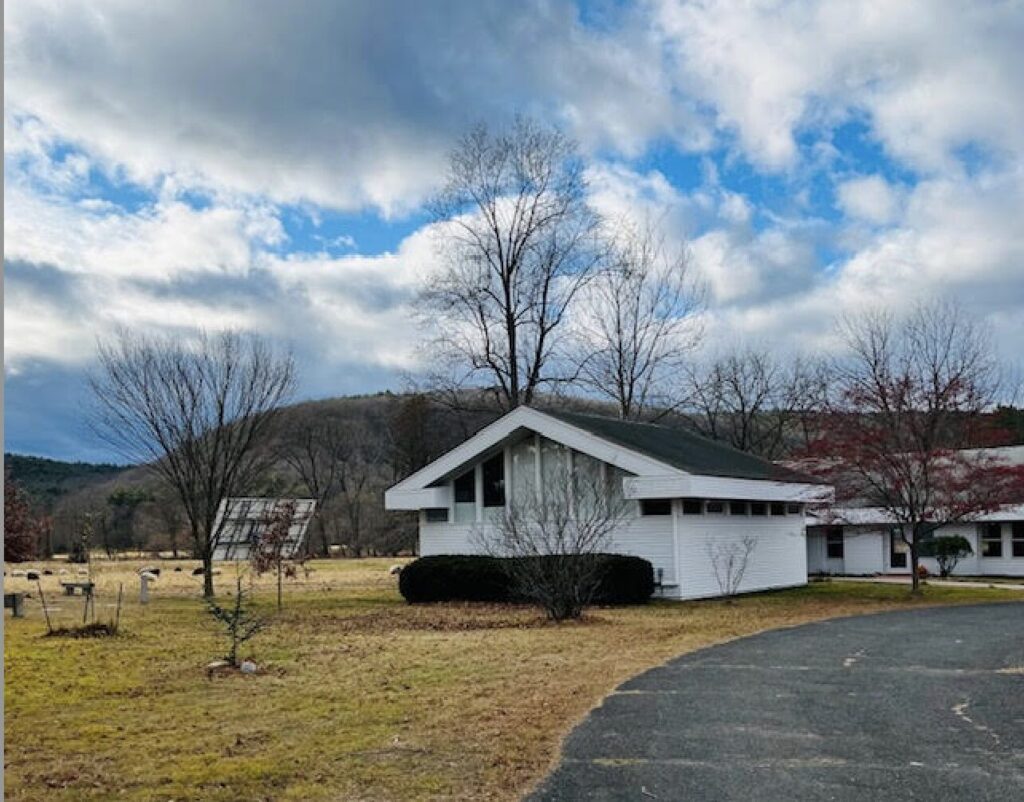
Mt. Toby Friends Meeting House, Leverett, MA. Photo: Hetty Startup
Amherst History Month by Month
This column is the seventh in a 10-part series about towns surrounding Amherst. Previous columns covered Pelham, Shutesbury, Sunderland, Hadley, Belchertown and Granby. For a listing of all previous “Amherst History Month by Month” columns, look here.
A part of Leverett that intrigues me whenever I travel back roads to see friends in Montague is the little hamlet at Depot Road at the odd intersection of Depot Road, Amherst Road and Long Hill Rd. near Leverett Pond. I want to know more about how this little cluster of homes functioned in the 1800s. I also want to know more about what we cannot see today but can uncover. One building known as the Stillman Field House sits at this intersection with Long Hill Road. It has Gothic Revival style windows and trim. It was apparently built in 1832 although this is very early in this country for examples of the Gothic Revival architectural style.
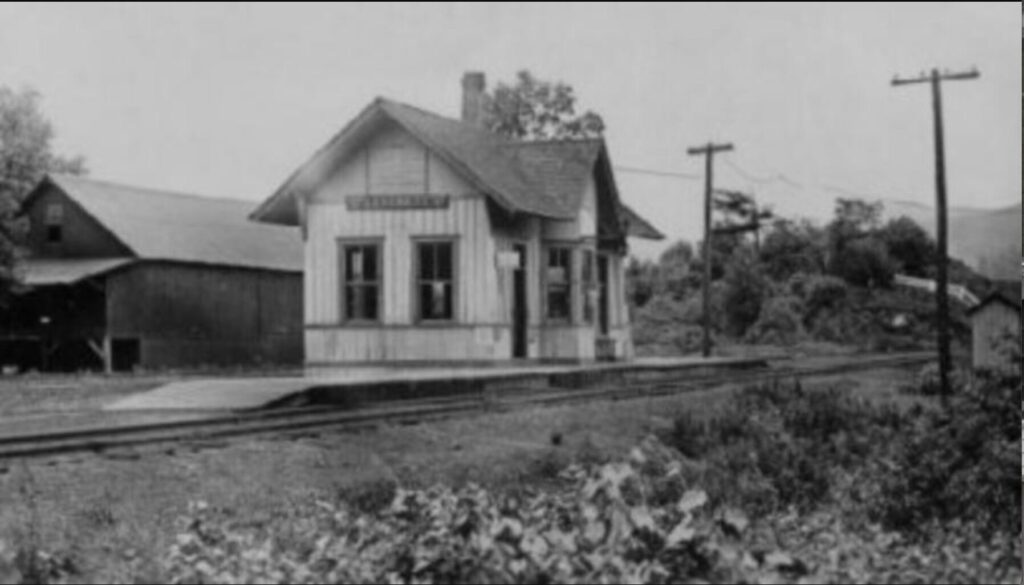
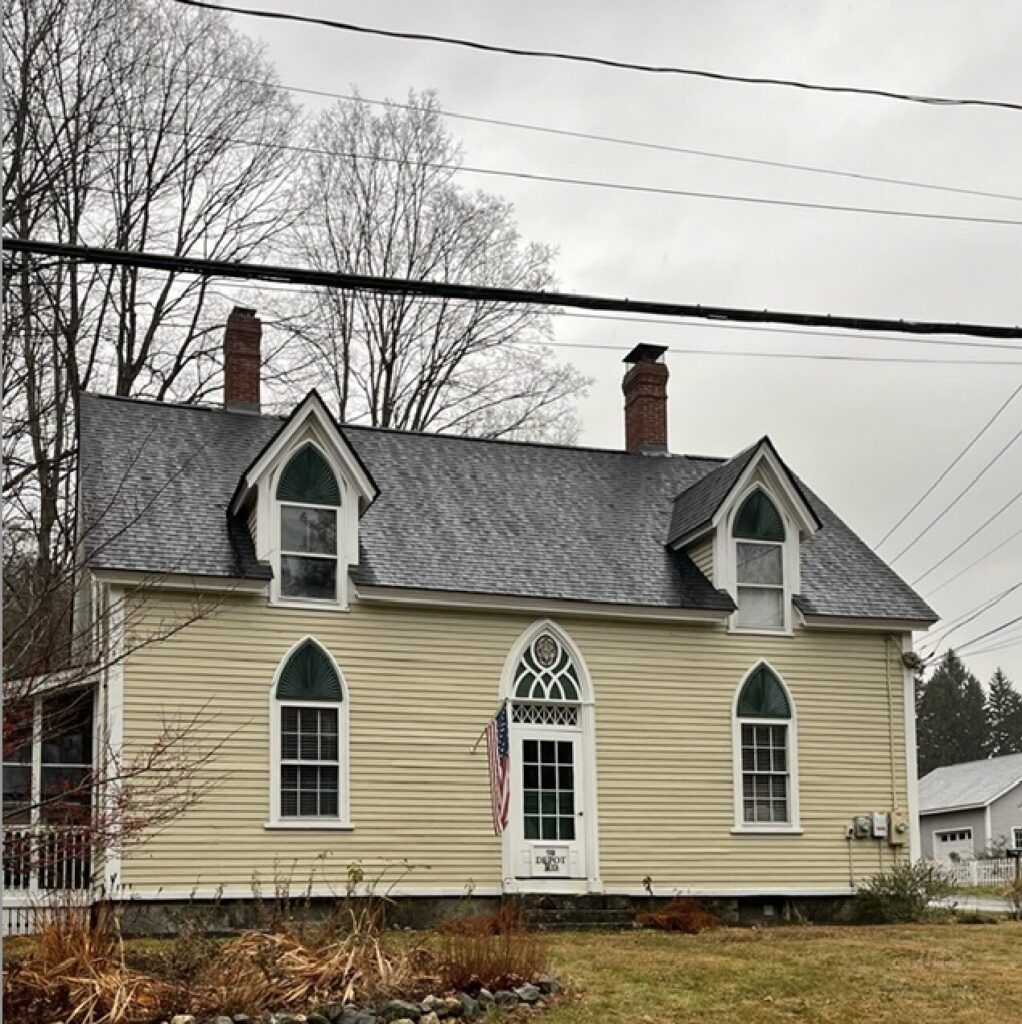
Perhaps the folks running the Field Family Sugarhouse further up Long Hill Road (where they have been maple sugaring since 1814) will tell me they are related? Research about the house for its listing on the Massachusetts Cultural Resources Information System (MACRIS) states “The quality of the details in the pointed-arch fans and fanlights suggests the hand of a fine local wood carver or perhaps the recycling of details from a church. Its pointed-arch fans above the principal windows bear a striking similarity to those on the First Congregational Church (4 Montague Road) raising the possibility that the same person built the house and the church.”
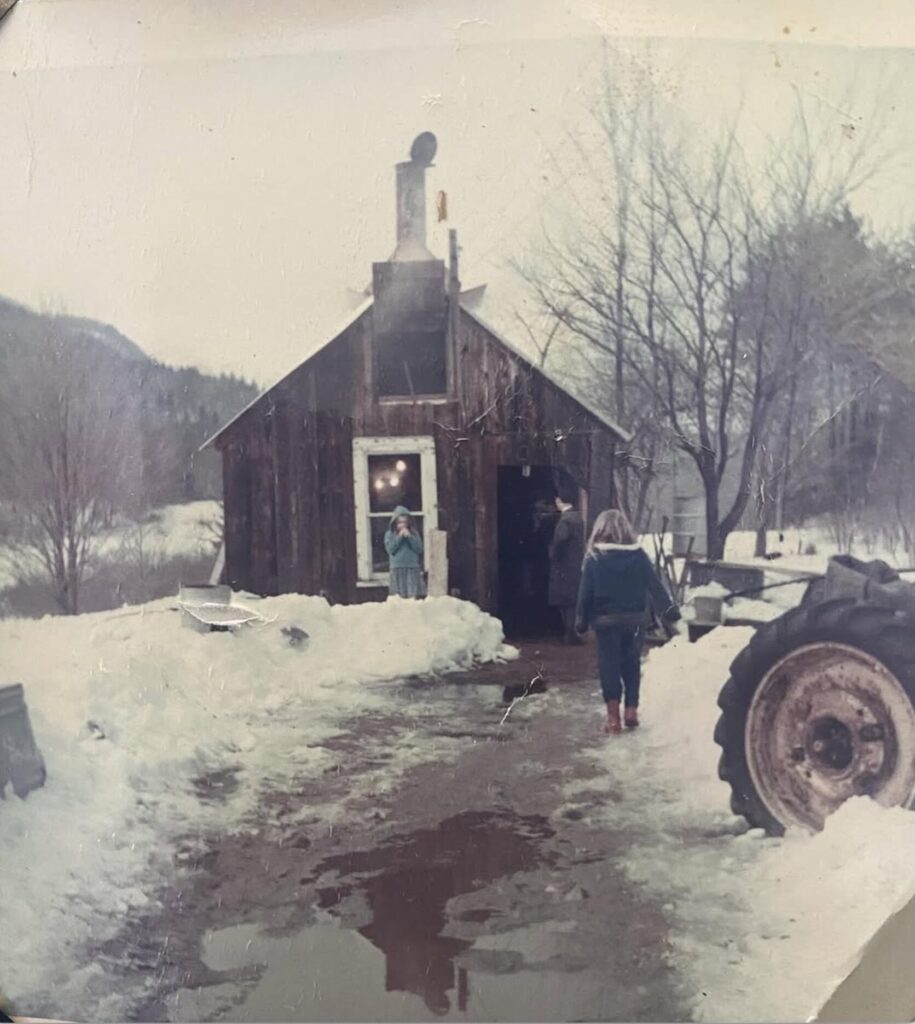
The house opposite Stillman Field House sits uphill from the road screened by mature trees. Another historic building at #111 Amherst Road, was the home of Erastus Salisbury Field, a significant American artist of the early to mid-1800s who finished out his days in Sunderland in the Plumtrees area.

When I first launched this series, a list at the end of the first article noted many towns and historic neighborhoods surrounding Amherst. With Leverett, I incorrectly identified it as in Hampshire county and I have to remind myself that it is part of Franklin county. The mistake, I believe, stems from the historic ways in which south (and perhaps east) Leverett orient to Amherst/Shutesbury, while North Leverett seems to pivot to Montague and further north into Franklin county. As the first of two articles about Leverett, this one is mostly about the southern end and that means I can give a shout out to places like Cushman that are on the north-eastern border of Amherst and Leverett.
Cushman was once known as “The City” or Factory City, a productive and rather sprawling mill village, like many others in New England, comprising several water-powered mills and factories situated along Cushman Brook (which becomes Mill River below the dam that impounds Puffers Pond). We need to remember that bodies of water are not naturally inclined to follow colonial boundaries and maps. Below is an early 19th century map which shows this area of Amherst. Leverett was once a part of Sunderland when Sunderland was known as Swampfield.
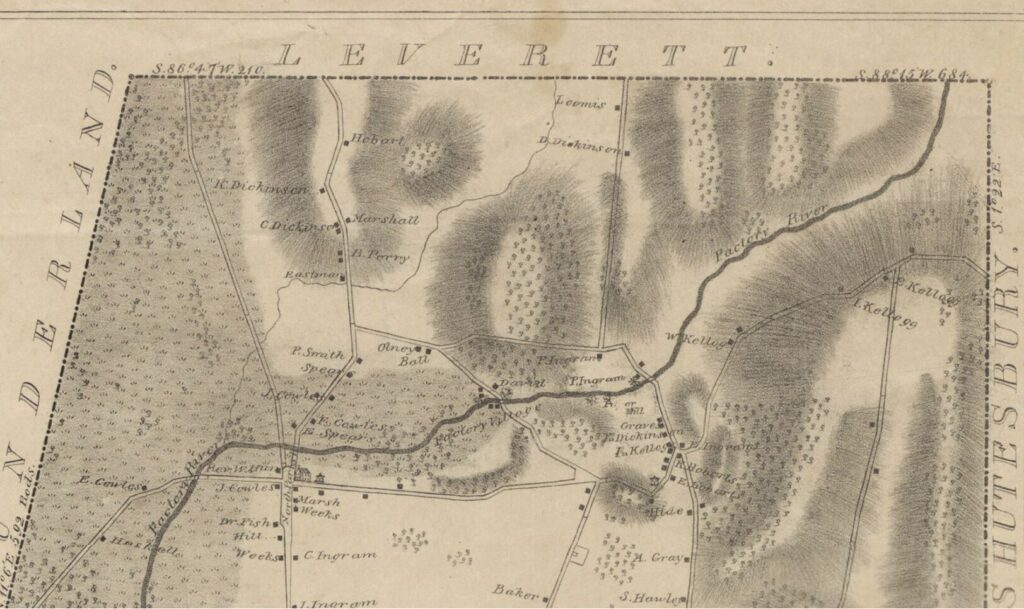
Leverett, named for John Leverett, the twentieth Governor of the Massachusetts Bay Colony, was settled as a town March 5, 1774, which at that time meant hiring or ‘settling” a Protestant minister to lead meetings in the meeting house. The town’s incorporation happened before the American Revolution and the date signifies when Leverett separated officially from Sunderland.
The southern part of Leverett intrigues me for a couple of reasons. Before these towns with English names existed, indigenous terms identified characteristics of the land, naming different needs, relationships and/or natural features. These names can be activated even though they are under the surface of more dominant historiography. The words, spoken by First Nations like the Pocumtuck and the Norwottuck, reinforce their ties to the land, which continue down to the present time. It is clear in newer published histories about the Connecticut River Valley that there existed a hybrid indigenous-colonial culture from about 1400-1700 CE that offer truer narratives of this place we all share.
Leverett has been observing its 250th anniversary this year. Year-long celebrations included the creation of a giant wooden birthday cake that has moved around from other nearby towns, like Whately, also celebrating anniversaries. It has been fun to follow it and the sight might remind some of the other giant birthday cakes in places like Deerfield (commemorating its 350th this year) or Westfield, MA. Leverett’s oldest human stewards of this land were the Norwottuck and the Pocumtuck who have over time merged with the Nipmuc peoples. In her talk this past April for the anniversary observances, Marge Bruchac confirmed that the Pocumtuck were actively living in Leverett in the 1600s as well as in Deerfield, and Greenfield.

One of the culminating events for the 250th anniversary happened last Sunday, November 17, when an interfaith service was held at Leverett Congregational church, adjacent to Leverett Pond. (I wonder what the pond’s name was in the language of the Pocumtuck or Nipmuc?) The service was sponsored by the Mount Toby Friends Meeting, the New England Peace Pagoda, and the Interfaith Opportunity Network of Hampshire County. Participants included the Bahá’í Community of Western Massachusetts, Hampshire Mosque / Islamic Society of Western Massachusetts, Hope Community Church, Hopping Tree Sangha, Jewish Community of Amherst, North Leverett Baptist Church, and the Unitarian Universalist Society of Amherst. The service focused on what is shared within these different wisdom traditions and each community offered up songs, chants, prayers, and/or a little of their history.
As described by the organizers, the service was inspired because “…When the town of Leverett was founded by [the Congregational] church in 1774, members of other traditions, especially the spiritual beliefs of native peoples, were not recognized. This has changed in our own times and Leverett is served by a host of different faith communities. Organizers hope[d] this service [would] help grow our awareness that no matter the differences in each of our traditions, we are all after the same function, which is to grow the love and peace that is at the heart of our human potential.”
I want to return to Leverett’s Depot Road turning west where it runs over the railroad tracks and out onto state road Route 63, a route that begins in North Amherst and continues north, through Sunderland, up to Northfield and across the border into New Hampshire. Just north of where Depot Road meets Long Plain Road is the Mount Toby Friends Meeting house, designed by Elroy Webber, on about 112 acres of land once owned by Ethel Dubois that she left to the Quakers in her will. The low-rise, modernist building includes the meeting space, as well as a library and a community room, often used for its excellent concert series (more about that here) and the site is surrounded by farmland where sheep graze under the shadow of Mount Toby.
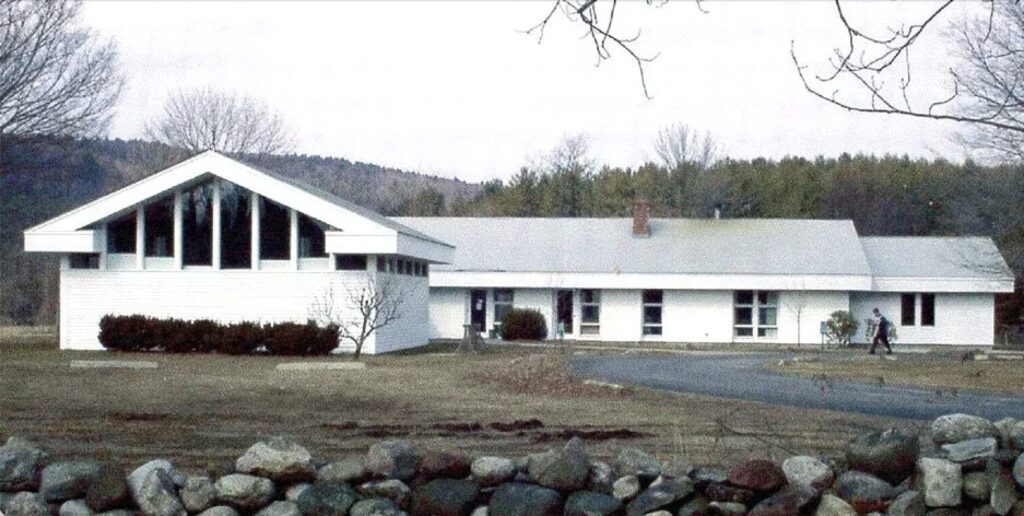
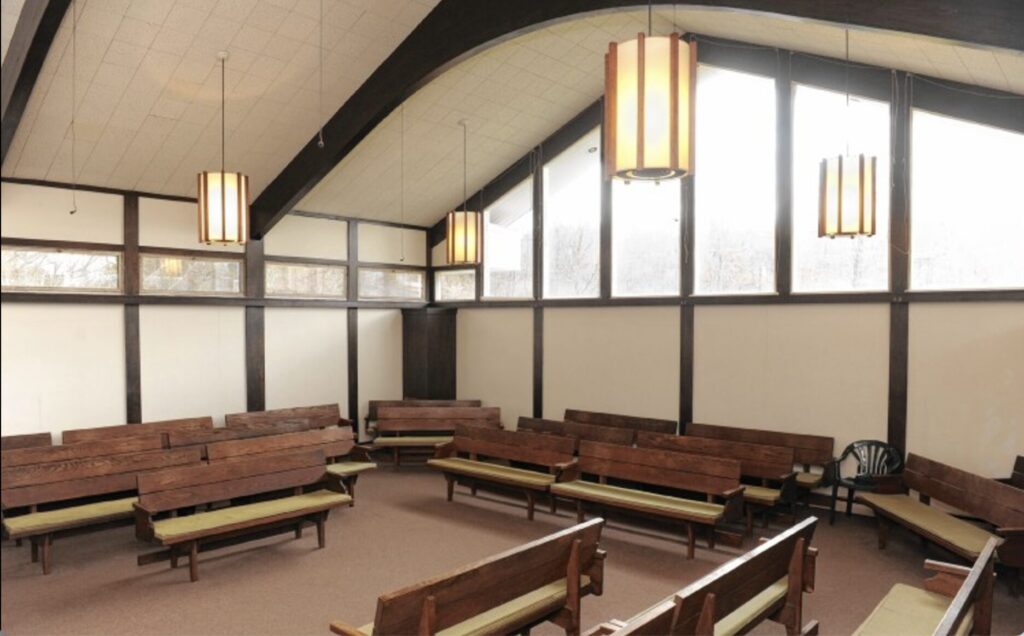
Elroy Webber, who died in 2002, was an energy-conscious architect based in Connecticut, who earned his architecture degree from MIT. In the early 1930s, he got interested in engineering and joined the Federation of Architects, Engineers, Chemists and Technicians, an organization intended to help stave off unemployment during the Great Depression. The organization was interested in affordable housing and the sorts of efficiencies possible with manufactured housing. After working briefly for architect and set designer Joseph Urban, who built the New School for Social Research in Manhattan, Elroy – as he was known to his clients – travelled to Europe and worked in Paris for Le Corbusier. He was also influenced like many in his generation by traditional Japanese design aesthetics. Then he returned to New England and set up his own practice, designing several modernist homes in Springfield and Longmeadow in Massachusetts, as well as other homes in Connecticut (featured in a 1958 issue of House Beautiful and a Tik Tok tour of the property) and New Jersey (featured in magazines about the contemporary home in 1954).
I want to stick with the theme of homes and housing to talk about this part of Leverett and what is newsworthy in a different way; that the 60-acre Kittredge Estate on Juggler Meadow Road is slated to be the site of a new housing development. Still in the planning stage, this news is of great interest to many people both in Leverett and in Amherst as plans call for homes to be built on the Amherst side of the town line, too.
First, a little history. The estate’s founder-owner was the Yankee Candle manufacturer Michael Kitteridge II (1952 –2019) and the main house on the estate is now lived in by his son, “Mick” Kitteridge, founder of Kringle Candle in nearby Bernardston. The main house takes its cue very loosely from both the Arts and Crafts Movement and the late 19th century architectural style sometimes called “Chateauesque.” It uses fieldstone for its foundation materials but is far from homespun in form or function; it has a private movie theater, an indoor tennis court and a home gym. Its three-lane bowling alley and billiards room do give the palatial house a retro feel. The expansive grounds include an impressive detached garage for high-end “motors” as my grandfather used to characterize cars (modelled perhaps on the Larz-Anderson estate in Brookline, MA). The link here to House Beautiful magazine is the best source for photos of the property, the boundaries of which are marked discreetly but unmistakably by a dark green wooden fence on Leverett and Amherst Roads.
Designs for the proposed housing project are to be carried out by Chris Ritter Studio, of Brookline, as a private commission. Ritter, who has his own firm now, used to work for the architectural and town planning firm, Andres Duany and Elizabeth Plater-Zyberk. Graduates of Yale architecture school, Duany-Plater-Zyberk are a well-known American architectural and planning firm, often referred to as the founders of the “New Urbanism” movement, who designed Seaside, Florida. [Insert images here of Seaside – perhaps the plan and a couple of examples.] The affordable housing firm SEB Housing is apparently set to manage the 40B parts of the proposed development. They may be familiar to Amherst Indy readers as the managers of 11-13 East Pleasant St. Chapter 40B is a state statute, which enables local Zoning Boards of Appeals to approve affordable housing developments under flexible rules if at least 20-25% of the units have long-term affordability restrictions.
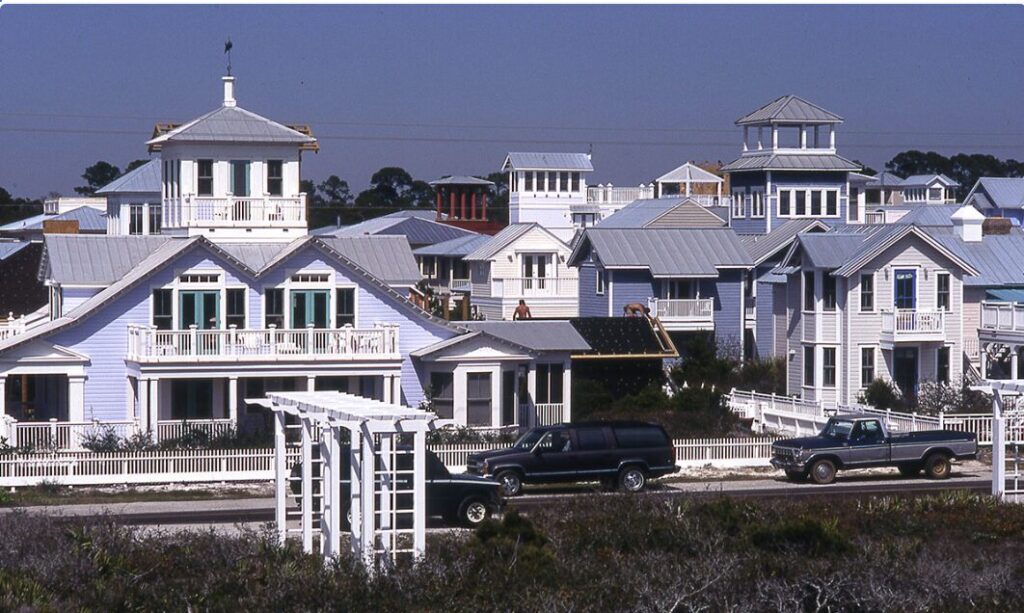
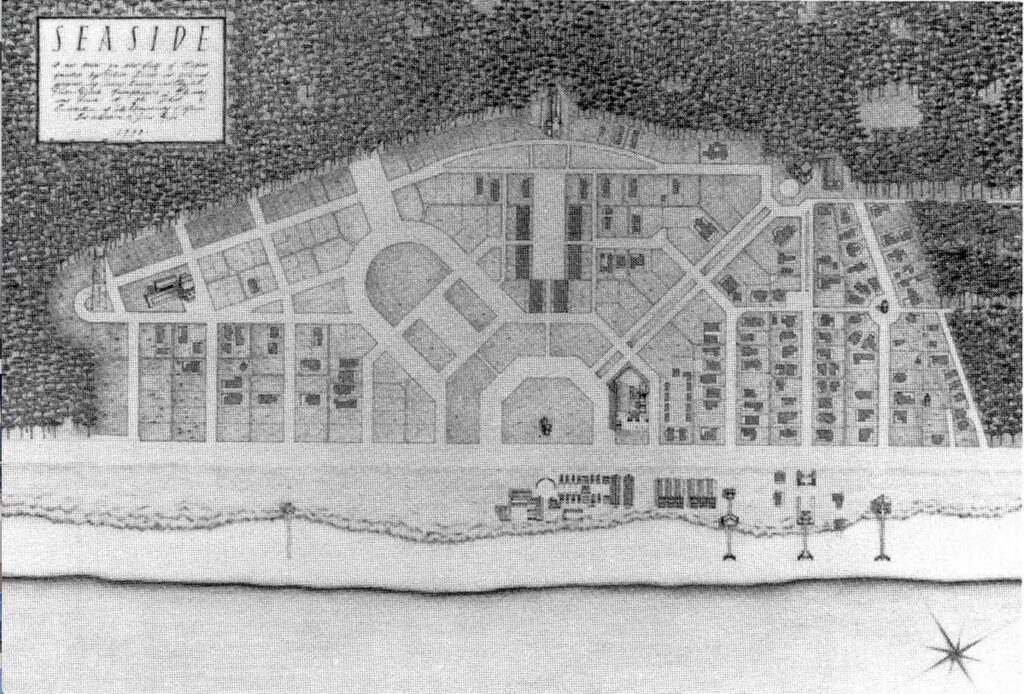
It is not the first time such developments have been entertained by the Kitteridge family. A more modest grouping of craftsman-style bungalows and cottages can be found on land close to the nearby Eastman Brook trail that are accessed from public roads. These homes are woodsy and off-the-beaten track in feel. I would show photos but I may have been trespassing while walking there without realizing it.
The details of the current proposals for the homes on the estate proper, possibly for people 55 and older, with some affordable units, are under review. It is also possible that there might be a sale of the entire property with these areas set aside for separate sales. Meetings related to the proposal have been covered by the Montague Reporter and suggest that as many as 90% of people making statements at a recent meeting were against the scheme, asserting that it would imperil the rural character of Leverett and especially burden its police and fire/emergency services. There would also need to be water and sewer connections laid in from the Amherst side. Lisa Brooks, an historian of Early American history, commented at a public meeting held in Leverett that the proposal echoed the creation of 47 lots sold in the 17th century from native Americans to colonial settlers. At the very least, she suggested that some homes be set aside for descendents of the Pocumtuck and the Norwottuck peoples, the earliest inhabitants of Leverett who were historically absorbed into the Nipmuc nation.
